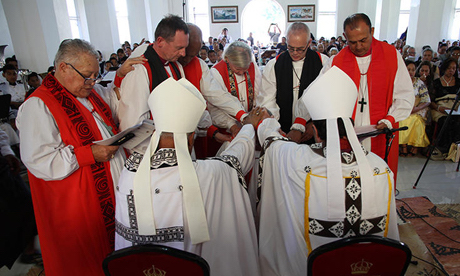The ordination of Dr ‘Afa Vaka as the first Anglican bishop of Tonga is the fulfilment of a long-held desire among Anglicans there for a greater level of autonomy within the Diocese of Polynesia.
Vaka, who was consecrated and installed on Sunday, is actually the third Anglican bishop to serve in Tonga.
Its first Anglican missionary was Bishop Alfred Willis who arrived in 1902. In the mid-1960s, Bishop Fine Halapua, the father of Archbishop Winston Halapua, lived in Tonga and served there as a suffragan bishop of the Diocese.
Vaka is Tonga’s first constitutionally-mandated bishop. His election follows the decision taken by the Diocesan synod in May to establish the Archdeaconry of Tonga as an episcopal unit.
Last Sunday’s service of consecration and installation saw a crowd of around 300 people squeezed in and around St Paul’s Church in Nuku’alofa.
During the service, Archbishop Halapua outlined the episcopal history of Tonga. He said that for the past 50 years, this distinct entity in the Pacific, with its own language, culture, traditions and fervent love for the monarchy, had been without its own bishop.
At his election, Vaka said having its own bishop puts the Anglican Church in Tonga “on another level.”
That new and more visible position will bring recognition – and mean a great deal to faithful Tongan Anglicans who live in the world’s only constitutionally-Methodist monarchy.
“For us,” he says, “it’s like a flower blooming. Or a bird that has begun to fly.”
‘Afa Vaka comes from a family with deep Anglican roots – four members of the Vaka family have been ordained priest and two more will be soon.
After graduating from St Andrew’s High School (Tonga’s Anglican college) as head boy in 1970, he immediately returned to help out as a volunteer woodwork teacher and was there for 32 years until he stepped down as principal.
Along the way, he’d picked up formal qualifications in woodwork and industrial arts – he set up an industrial arts department at the school – and a Bachelor of Education from the University of the South Pacific.
Source
